Synthesis and Characterization of the Mixed Metal Oxide of ZnO-TiO2 Decorated by Polyaniline as a Protective Film for Acidic Steel Corrosion: Experimental, and Computational Inspections
Abstract
1. Introduction
2. Materials and Methods
2.1. Materials, Solutions, and Sample Preparation
2.2. Preparation of ZnO·TiO2 Nanoparticles
2.2.1. Fabrication of ZnO-Nanoparticles
2.2.2. Preparation of ZnO-TiO2 Binary Metal Oxide Nanoparticles
2.2.3. Preparation of ZnO·TiO2/PANI Nanocomposites
2.3. Characterization Techniques
2.4. Electrochemical Experiments
2.5. Preparation of the Specimens for the Corrosion Inhibition Experimentations
2.6. Computational Information
3. Results and Discussion
3.1. Characterization of the Prepared Material
3.1.1. SEM, TEM, XRD, and DLS Investigations
3.1.2. FT-IR and UV–Visible Spectroscopy
3.1.3. Surface Chemistry Analysis
3.1.4. BET Surface Area and Thermal Analysis
3.2. Corrosion protection studies
3.2.1. Open Circuit Potential vs. Time and PDP Studies
3.2.2. EIS Studies
3.3. DFT Calculations
3.4. MC Simulations
3.5. Comparative Studies with Previous Reports
4. Conclusions
- The SEM and TEM descriptions confirmed that the fabricated ZnTiO@PANi composite has a heterogeneous morphology containing crystalline (oxide) and amorphous (polymer) parts. Moreover, the XPS analysis approves that the surface chemistry of the synthesized nanocomposite has C as a major content in addition to O, N, Zn, and Ti.
- The produced nanocomposite (ZnTiO@PANi) exhibits sufficient acidic inhibitory efficacy. The maximal dose of 100 mg/L of PANi and ZnTiO@PANi gave protective capabilities of 82.11 and 98.86%, respectively.
- The PDP method revealed that the addition of the ZnTiO@PANi composite material leads to a noticeable decrease in the jcor and both cathodic and anodic slopes. This result shows the mixed type of ZnTiO@PANi composite.
- According to the EIS results, the polarization resistance values (Rp) increased with a higher dose of the ZnTiO@PANi compound than in the blank system, confirming a greater degree of protection provided by the addition of the nanocomposites.
- The protective ability, as assessed by empirical testing, was related to the theoretical findings. Using MC and DFT studies, further information was discovered on the reactivity centers and adsorption energies for the attraction of ZnTiO@PANi on the Fe (110) interface, respectively.
- In short, this study presented a novel ZnTiO@PANi composite as a powerful acidic corrosion inhibitor with the study of many characterization tools and DFT studies to understand the chemistry and mechanism of inhibition.
Supplementary Materials
Author Contributions
Funding
Institutional Review Board Statement
Informed Consent Statement
Data Availability Statement
Acknowledgments
Conflicts of Interest
References
- Goyal, A.; Pouya, H.S.; Ganjian, E.; Claisse, P. A review of corrosion and protection of steel in concrete. Arab. J. Sci. Eng. 2018, 43, 5035–5055. [Google Scholar] [CrossRef]
- Hosseini, S.G.; Abazari, R. A facile one-step route for production of CuO, NiO, and CuO–NiO nanoparticles and comparison of their catalytic activity for ammonium perchlorate decomposition. RSC Adv. 2015, 5, 96777–96784. [Google Scholar] [CrossRef]
- Lin, J.; Dahan, I. Nanostructured chromium coatings with enhanced mechanical properties and corrosion resistance. Surf. Coat. Technol. 2015, 265, 154–159. [Google Scholar] [CrossRef]
- Abd El-Lateef, H.M.; Khalaf, M.M. Novel dispersed Tl2O3-SiO2/polyaniline nanocomposites: In-situ polymerization, characterization and enforcement as a corrosion protective layer for carbon-steel in acidic chloride medium. Colloids Surf. A Physicochem. Eng. Asp. 2019, 573, 95–111. [Google Scholar] [CrossRef]
- Finšgar, M.; Jackson, J. Application of corrosion inhibitors for steels in acidic media for the oil and gas industry: A review. Corros. Sci. 2014, 86, 17–41. [Google Scholar] [CrossRef]
- de Souza, F.S.; Spinelli, A. Caffeic acid as a green corrosion inhibitor for mild steel. Corros. Sci. 2009, 51, 642–649. [Google Scholar] [CrossRef]
- Caterina, M.C.; Perillo, I.A.; Boiani, L.; Pezaroglo, H.; Cerecetto, H.; González, M.; Salerno, A. Imidazolidines as new anti-Trypanosoma cruzi agents: Biological evaluation and structure–activity relationships. Bioorganic Med. Chem. 2008, 16, 2226–2234. [Google Scholar] [CrossRef]
- Zhao, Y.; Zhang, Z.; Yu, L. Corrosion protection of carbon steel by electrospun film containing polyaniline microfibers. React. Funct. Polym. 2016, 102, 20–26. [Google Scholar] [CrossRef]
- Sharma, S.; Pande, S.S.; Swaminathan, P. Top-down synthesis of zinc oxide based inks for inkjet printing. RSC Adv. 2017, 7, 39411–39419. [Google Scholar] [CrossRef]
- Kumar, H.; Boora, A.; Yadav, A.; Rajni; Rahul. Polyaniline-metal oxide-nano-composite as a nano-electronics, opto-electronics, heat resistance and anticorrosive material. Results Chem. 2020, 2, 100046. [Google Scholar] [CrossRef]
- Alnajjar, A.O.; Abd El-Lateef, H.M.; Khalaf, M.M.; Mohamed, I.M.A. Steel protection in acidified 3.5% NaCl by novel hybrid composite of CoCrO3/polyaniline: Chemical fabrication, physicochemical properties, and corrosion inhibition performance. Constr. Build. Mater. 2022, 317, 125918. [Google Scholar] [CrossRef]
- Corvo, F.; Perez, T.; Dzib, L.R.; Martin, Y.; Castañeda, A.; Gonzalez, E.; Perez, J. Outdoor–indoor corrosion of metals in tropical coastal atmospheres. Corros. Sci. 2008, 50, 220–230. [Google Scholar] [CrossRef]
- Vivar Mora, L.; Naik, S.; Paul, S.; Dawson, R.; Neville, A.; Barker, R. Influence of silica nanoparticles on corrosion resistance of sol-gel based coatings on mild steel. Surf. Coat. Technol. 2017, 324, 368–375. [Google Scholar] [CrossRef]
- Eftekhari, A. Nanostructured Conductive Polymers; John Wiley & Sons: Hoboken, NJ, USA, 2011. [Google Scholar]
- Jiang, Y.; Shi, K.; Tang, H.; Wang, Y. Enhanced wettability and wear resistance on TiO2/PDA thin films prepared by sol-gel dip coating. Surf. Coat. Technol. 2019, 375, 334–340. [Google Scholar] [CrossRef]
- Shen, G.X.; Chen, Y.C.; Lin, C.J. Corrosion protection of 316 L stainless steel by a TiO2 nanoparticle coating prepared by sol–gel method. Thin Solid Film. 2005, 489, 130–136. [Google Scholar] [CrossRef]
- Mombrú, D.; Romero, M.; Faccio, R.; Castiglioni, J.; Mombrú, A.W. In situ growth of ceramic quantum dots in polyaniline host via water vapor flow diffusion as potential electrode materials for energy applications. J. Solid State Chem. 2017, 250, 60–67. [Google Scholar] [CrossRef]
- Yun, H.; Lin, C.; Li, J.; Wang, J.; Chen, H. Low-temperature hydrothermal formation of a net-like structured TiO2 film and its performance of photogenerated cathode protection. Appl. Surf. Sci. 2008, 255, 2113–2117. [Google Scholar] [CrossRef]
- Fradi, K.; Bouich, A.; Slimi, B.; Chtourou, R. Towards improving the optoelectronics properties of MAPbI3(1−x)B3x/ZnO heterojunction by bromine doping. Optik 2022, 249, 168283. [Google Scholar] [CrossRef]
- Shafi, M.A.; Bouich, A.; Fradi, K.; Guaita, J.M.; Khan, L.; Mari, B. Effect of deposition cycles on the properties of ZnO thin films deposited by spin coating method for CZTS-based solar cells. Optik 2022, 258, 168854. [Google Scholar] [CrossRef]
- Geetha, M.S.; Nagabhushana, H.; Shivananjaiah, H.N. Green mediated synthesis and characterization of ZnO nanoparticles using Euphorbia Jatropa latex as reducing agent. J. Sci. Adv. Mater. Devices 2016, 1, 301–310. [Google Scholar] [CrossRef]
- Al-Masoud, M.A.; Khalaf, M.M.; Mohamed, I.M.A.; Shalabi, K.; Abd El-Lateef, H.M. Computational, kinetic, and electrochemical studies of polyaniline functionalized ZnO and ZnO-SiO2 nanoparticles as corrosion protection films on carbon steel in acidic sodium chloride solutions. J. Ind. Eng. Chem. 2022, 112, 398–422. [Google Scholar] [CrossRef]
- Al Abdullah, K.; Awad, S.; Zaraket, J.; Salame, C. Synthesis of ZnO Nanopowders By Using Sol-Gel and Studying Their Structural and Electrical Properties at Different Temperature. Energy Procedia 2017, 119, 565–570. [Google Scholar] [CrossRef]
- Abd El-Lateef, H.M.; Sayed, A.R.; Shalabi, K. Synthesis and theoretical studies of novel conjugated polyazomethines and their application as efficient inhibitors for C1018 steel pickling corrosion behavior. Surf. Interfaces 2021, 23, 101037. [Google Scholar] [CrossRef]
- El-Lateef, H.M.A.; Abdallah, Z.A.; Ahmed, M.S.M. Solvent-free synthesis and corrosion inhibition performance of Ethyl 2-(1,2,3,6-tetrahydro-6-oxo-2-thioxopyrimidin-4-yl)ethanoate on carbon steel in pickling acids: Experimental, quantum chemical and Monte Carlo simulation studies. J. Mol. Liq. 2019, 296, 111800. [Google Scholar] [CrossRef]
- Dehghani, A.; Mostafatabar, A.H.; Bahlakeh, G.; Ramezanzadeh, B. A detailed study on the synergistic corrosion inhibition impact of the Quercetin molecules and trivalent europium salt on mild steel; electrochemical/surface studies, DFT modeling, and MC/MD computer simulation. J. Mol. Liq. 2020, 316, 113914. [Google Scholar] [CrossRef]
- Feng, Y.; Chen, S.; Guo, W.; Zhang, Y.; Liu, G. Inhibition of iron corrosion by 5,10,15,20-tetraphenylporphyrin and 5,10,15,20-tetra-(4-chlorophenyl)porphyrin adlayers in 0.5M H2SO4 solutions. J. Electroanal. Chem. 2007, 602, 115–122. [Google Scholar] [CrossRef]
- Abd El-Lateef, H.M.; Shalabi, K.; Tantawy, A.H. Corrosion inhibition and adsorption features of novel bioactive cationic surfactants bearing benzenesulphonamide on C1018-steel under sweet conditions: Combined modeling and experimental approaches. J. Mol. Liq. 2020, 320, 114564. [Google Scholar] [CrossRef]
- Ashkarran, A.A.; Iraji zad, A.; Mahdavi, S.M.; Ahadian, M.M. ZnO nanoparticles prepared by electrical arc discharge method in water. Mater. Chem. Phys. 2009, 118, 6–8. [Google Scholar] [CrossRef]
- Jiang, L.; Cui, Z. One-step synthesis of oriented polyaniline nanorods through electrochemical deposition. Polym. Bull. 2006, 56, 529–537. [Google Scholar] [CrossRef]
- Pawar, S.; Patil, S.; Chougule, M.; Mane, A.; Jundale, D.; Patil, V. Synthesis and characterization of polyaniline: TiO2 nanocomposites. Int. J. Polym. Mater. 2010, 59, 777–785. [Google Scholar] [CrossRef]
- Yasin, A.S.; Mohamed, I.M.A.; Park, C.H.; Kim, C.S. Design of novel electrode for capacitive deionization using electrospun composite titania/zirconia nanofibers doped-activated carbon. Mater. Lett. 2018, 213, 62–66. [Google Scholar] [CrossRef]
- Zhang, J.; Raza, S.; Wang, P.; Wen, H.; Zhu, Z.; Huang, W.; Mohamed, I.M.A.; Liu, C. Polymer brush-grafted ZnO-modified cotton for efficient oil/water separation with abrasion/acid/alkali resistance and temperature “switch” property. J. Colloid Interface Sci. 2020, 580, 822–833. [Google Scholar] [CrossRef] [PubMed]
- Abd El-Lateef, H.M.; Mohamed, I.M.A.; Zhu, J.-H.; Khalaf, M.M. An efficient synthesis of electrospun TiO2-nanofibers/Schiff base phenylalanine composite and its inhibition behavior for C-steel corrosion in acidic chloride environments. J. Taiwan Inst. Chem. Eng. 2020, 112, 306–321. [Google Scholar] [CrossRef]
- Chen, J.; Liu, L.; Huang, J.; Sheng, C.; Li, L. Porous multicomponent chitosan/poly(ε-caprolactone)-block poly (ethylene glycol)/SiO2 aerogel@polydopamine membrane for Congo red adsorption. Mater. Today Chem. 2022, 23, 100661. [Google Scholar] [CrossRef]
- Murmu, M.; Saha, S.K.; Bhaumick, P.; Murmu, N.C.; Hirani, H.; Banerjee, P. Corrosion inhibition property of azomethine functionalized triazole derivatives in 1 mol L−1 HCl medium for mild steel: Experimental and theoretical exploration. J. Mol. Liq. 2020, 313, 113508. [Google Scholar] [CrossRef]
- Saha, S.K.; Dutta, A.; Ghosh, P.; Sukul, D.; Banerjee, P. Adsorption and corrosion inhibition effect of Schiff base molecules on the mild steel surface in 1 M HCl medium: A combined experimental and theoretical approach. Phys. Chem. Chem. Phys. 2015, 17, 5679–5690. [Google Scholar] [CrossRef]
- Saha, S.K.; Murmu, M.; Murmu, N.C.; Banerjee, P. Evaluating electronic structure of quinazolinone and pyrimidinone molecules for its corrosion inhibition effectiveness on target specific mild steel in the acidic medium: A combined DFT and MD simulation study. J. Mol. Liq. 2016, 224, 629–638. [Google Scholar] [CrossRef]
- Upadhyay, A.; Purohit, A.K.; Mahakur, G.; Dash, S.; Kar, P.K. Verification of corrosion inhibition of Mild steel by some 4-Aminoantipyrine-based Schiff bases–Impact of adsorbate substituent and cross-conjugation. J. Mol. Liq. 2021, 333, 115960. [Google Scholar] [CrossRef]
- Abd El-Lateef, H.M.; El-Remaily, M.A.A.A.; Khodairy, A.; Sayed, M.M.; Yehia, N.; . Khalaf, M.M.; Aly, K.I. Synthesis and structure design of novel unsaturated Copolyesters based on indazole moiety in the main chain with good thermal stability for catalytic activity and anti-corrosion applications. J. Mol. Struc. 2023, 1273, 134345. [Google Scholar] [CrossRef]
- Farag, A.A.; Ali, T.A. The enhancing of 2-pyrazinecarboxamide inhibition effect on the acid corrosion of carbon steel in presence of iodide ions. J. Ind. Eng. Chem. 2015, 21, 627–634. [Google Scholar] [CrossRef]
- Cao, S.; Liu, D.; Ding, H.; Wang, J.; Lu, H.; Gui, J. Task-specific ionic liquids as corrosion inhibitors on carbon steel in 0.5 M HCl solution: An experimental and theoretical study. Corros. Sci. 2019, 153, 301–313. [Google Scholar] [CrossRef]
- Fekry, A.M.; Mohamed, R.R. Acetyl thiourea chitosan as an eco-friendly inhibitor for mild steel in sulphuric acid medium. Electrochim. Acta 2010, 55, 1933–1939. [Google Scholar] [CrossRef]
- Arellanes-Lozada, P.; Díaz-Jiménez, V.; Hernández-Cocoletzi, H.; Nava, N.; Olivares-Xometl, O.; Likhanova, N.V. Corrosion inhibition properties of iodide ionic liquids for API 5L X52 steel in acid medium. Corros. Sci. 2020, 175, 108888. [Google Scholar] [CrossRef]
- Haque, J.; Srivastava, V.; Verma, C.; Quraishi, M. Experimental and quantum chemical analysis of 2-amino-3-((4-((S)-2-amino-2-carboxyethyl)-1H-imidazol-2-yl) thio) propionic acid as new and green corrosion inhibitor for mild steel in 1 M hydrochloric acid solution. J. Mol. Liq. 2017, 225, 848–855. [Google Scholar] [CrossRef]
- Fuchs-Godec, R.; Pavlović, M.G. Synergistic effect between non-ionic surfactant and halide ions in the forms of inorganic or organic salts for the corrosion inhibition of stainless-steel X4Cr13 in sulphuric acid. Corros. Sci. 2012, 58, 192–201. [Google Scholar] [CrossRef]
- Hsu, C.; Mansfeld, F. Concerning the conversion of the constant phase element parameter Y0 into a capacitance. Corrosion 2001, 57, 747–748. [Google Scholar] [CrossRef]
- Solomon, M.M.; Gerengi, H.; Kaya, T.; Kaya, E.; Umoren, S.A. Synergistic inhibition of St37 steel corrosion in 15% H2SO4 solution by chitosan and iodide ion additives. Cellulose 2017, 24, 931–950. [Google Scholar] [CrossRef]
- Zheng, X.; Zhang, S.; Li, W.; Gong, M.; Yin, L. Experimental and theoretical studies of two imidazolium-based ionic liquids as inhibitors for mild steel in sulfuric acid solution. Corros. Sci. 2015, 95, 168–179. [Google Scholar] [CrossRef]
- Onyeachu, I.B.; Obot, I.B.; Sorour, A.A.; Abdul-Rashid, M.I. Green corrosion inhibitor for oilfield application I: Electrochemical assessment of 2-(2-pyridyl) benzimidazole for API X60 steel under sweet environment in NACE brine ID196. Corros. Sci. 2019, 150, 183–193. [Google Scholar] [CrossRef]
- Sha, J.-Y.; Ge, H.-H.; Wan, C.; Wang, L.-T.; Xie, S.-Y.; Meng, X.-J.; Zhao, Y.-Z. Corrosion inhibition behaviour of sodium dodecyl benzene sulphonate for brass in an Al2O3 nanofluid and simulated cooling water. Corros. Sci. 2019, 148, 123–133. [Google Scholar] [CrossRef]
- Sharma, D.; Singh, T. A DFT study of polyaniline/ZnO nanocomposite as a photocatalyst for the reduction of methylene blue dye. J. Mol. Liq. 2019, 293, 111528. [Google Scholar] [CrossRef]
- Palaniappan, N.; Cole, I.S.; Kuznetsov, A.E. Experimental and computational studies of graphene oxide covalently functionalized by octylamine: Electrochemical stability, hydrogen evolution, and corrosion inhibition of the AZ13 Mg alloy in 3.5% NaCl. RSC Adv. 2020, 10, 11426–11434. [Google Scholar] [CrossRef] [PubMed]
- Lukovits, I.; Kalman, E.; Zucchi, F. Corrosion inhibitors—Correlation between electronic structure and efficiency. Corrosion 2001, 57, 3–8. [Google Scholar] [CrossRef]
- Yesudass, S.; Olasunkanmi, L.O.; Bahadur, I.; Kabanda, M.M.; Obot, I.B.; Ebenso, E.E. Experimental and theoretical studies on some selected ionic liquids with different cations/anions as corrosion inhibitors for mild steel in acidic medium. J. Taiwan Inst. Chem. Eng. 2016, 64, 252–268. [Google Scholar] [CrossRef]
- Debab, H.; Douadi, T.; Daoud, D.; Issaadi, S.; Chafaa, S. Electrochemical and quantum chemical studies of adsorption and corrosion inhibition of two new Schiff bases on carbon steel in hydrochloric acid media. Int. J. Electrochem. Sci. 2018, 13, 6958–6977. [Google Scholar] [CrossRef]
- Gao, G.; Liang, C. Electrochemical and DFT studies of β-amino-alcohols as corrosion inhibitors for brass. Electrochim. Acta 2007, 52, 4554–4559. [Google Scholar] [CrossRef]
- Abd El-Lateef, H.M.; Shalabi, K.; Tantawy, A.H. Corrosion inhibition of carbon steel in hydrochloric acid solution using newly synthesized urea-based cationic fluorosurfactants: Experimental and computational investigations. New J. Chem. 2020, 44, 17791–17814. [Google Scholar] [CrossRef]
- Goyal, M.; Vashist, H.; Kumar, S.; Bahadur, I.; Benhiba, F.; Zarrouk, A. Acid corrosion inhibition of ferrous and non-ferrous metal by nature friendly Ethoxycarbonylmethyltriphenylphosphonium Bromide (ECMTPB): Experimental and MD simulation evaluation. J. Mol. Liq. 2020, 315, 113705. [Google Scholar] [CrossRef]
- Oyebamiji, A.; Adeleke, B. Quantum chemical studies on inhibition activities of 2, 3-dihydroxypropyl-sulfanyl derivative on carbon steel in acidic media. Int. J. Corros. Scale Inhib. 2018, 7, 498–508. [Google Scholar]
- Hsissou, R.; Abbout, S.; Safi, Z.; Benhiba, F.; Wazzan, N.; Guo, L.; Nouneh, K.; Briche, S.; Erramli, H.; Ebn Touhami, M.; et al. Synthesis and anticorrosive properties of epoxy polymer for CS in [1 M] HCl solution: Electrochemical, AFM, DFT and MD simulations. Constr. Build. Mater. 2021, 270, 121454. [Google Scholar]
- Guo, L.; Safi, Z.S.; Kaya, S.; Shi, W.; Tüzün, B.; Altunay, N.; Kaya, C. Anticorrosive effects of some thiophene derivatives against the corrosion of iron: A computational study. Front. Chem. 2018, 6, 155. [Google Scholar] [CrossRef] [PubMed]
- Hsissou, R. Review on epoxy polymers and its composites as a potential anticorrosive coatings for carbon steel in 3.5% NaCl solution: Computational approaches. J. Mol. Liq. 2021, 336, 116307. [Google Scholar] [CrossRef]
- Gece, G.; Bilgiç, S. Quantum chemical study of some cyclic nitrogen compounds as corrosion inhibitors of steel in NaCl media. Corros. Sci. 2009, 51, 1876–1878. [Google Scholar] [CrossRef]
- Madkour, L.H.; Kaya, S.; Obot, I.B. Computational, Monte Carlo simulation and experimental studies of some arylazotriazoles (AATR) and their copper complexes in corrosion inhibition process. J. Mol. Liq. 2018, 260, 351–374. [Google Scholar] [CrossRef]
- Shalabi, K.; Helmy, A.M.; El-Askalany, A.H.; Shahba, M.M. New pyridinium bromide mono-cationic surfactant as corrosion inhibitor for carbon steel during chemical cleaning: Experimental and theoretical studies. J. Mol. Liq. 2019, 293, 111480. [Google Scholar] [CrossRef]
- Özcan, M.; Dehri, İ.; Erbil, M. Organic sulphur-containing compounds as corrosion inhibitors for mild steel in acidic media: Correlation between inhibition efficiency and chemical structure. Appl. Surf. Sci. 2004, 236, 155–164. [Google Scholar] [CrossRef]
- Radhakrishnan, S.; Siju, C.R.; Mahanta, D.; Patil, S.; Madras, G. Conducting polyaniline–nano-TiO2 composites for smart corrosion resistant coatings. Electrochim. Acta 2009, 54, 1249–1254. [Google Scholar] [CrossRef]
- Mostafaei, A.; Nasirpouri, F. Epoxy/polyaniline–ZnO nanorods hybrid nanocomposite coatings: Synthesis, characterization and corrosion protection performance of conducting paints. Prog. Org. Coat. 2014, 77, 146–159. [Google Scholar] [CrossRef]
- Ates, M.; Topkaya, E. Nanocomposite film formations of polyaniline via TiO2, Ag, and Zn, and their corrosion protection properties. Prog. Org. Coat. 2015, 82, 33–40. [Google Scholar] [CrossRef]
- Jadhav, N.; Kasisomayajula, S.; Gelling, V.J. Polypyrrole/metal oxides-based composites/nanocomposites for corrosion protection. Front. Mater. 2020, 7, 95. [Google Scholar] [CrossRef]
- Khodair, Z.T.; Khadom, A.A.; Jasim, H.A. Corrosion protection of mild steel in different aqueous media via epoxy/nanomaterial coating: Preparation, characterization and mathematical views. J. Mater. Res. Technol. 2019, 8, 424–435. [Google Scholar] [CrossRef]
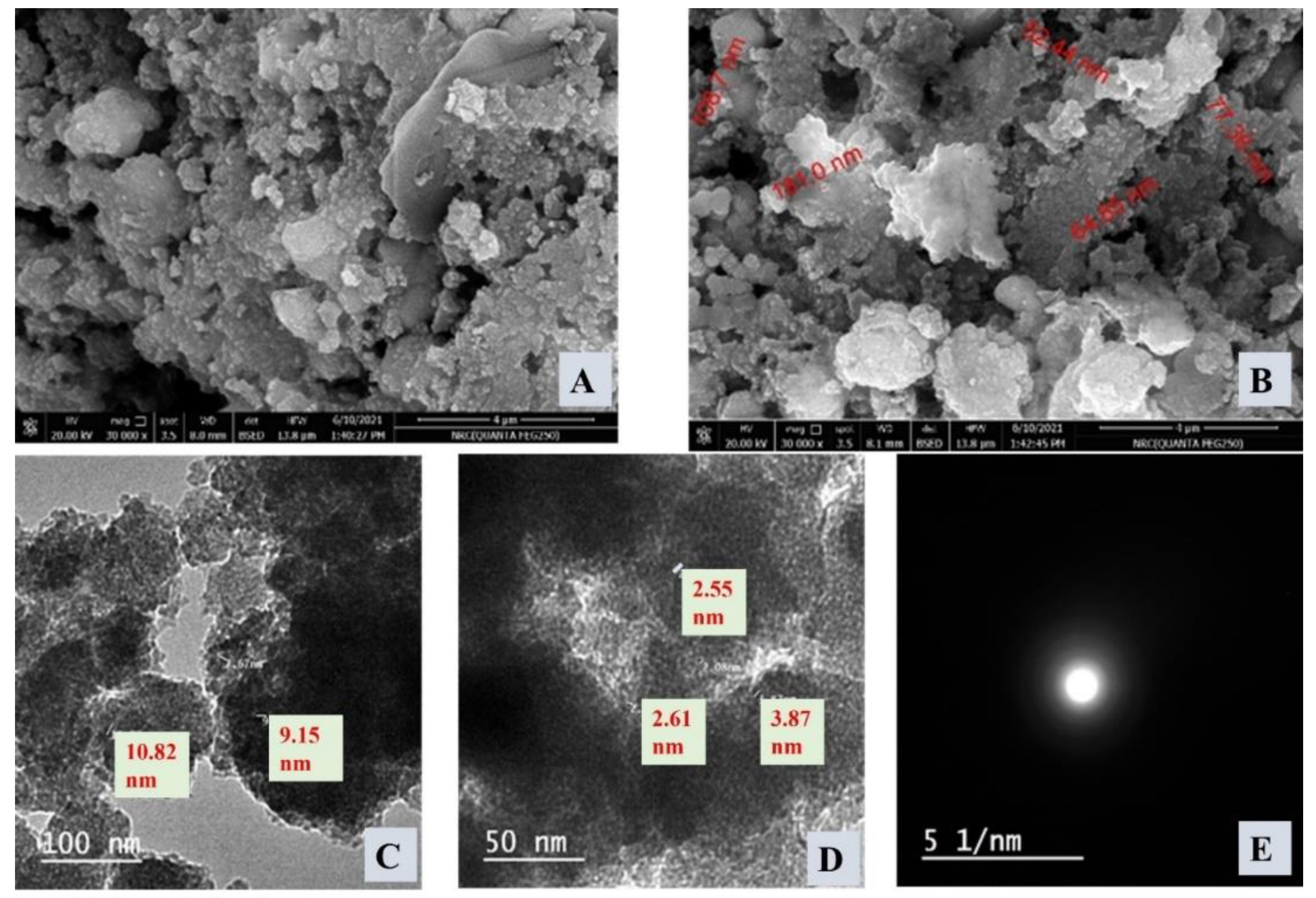
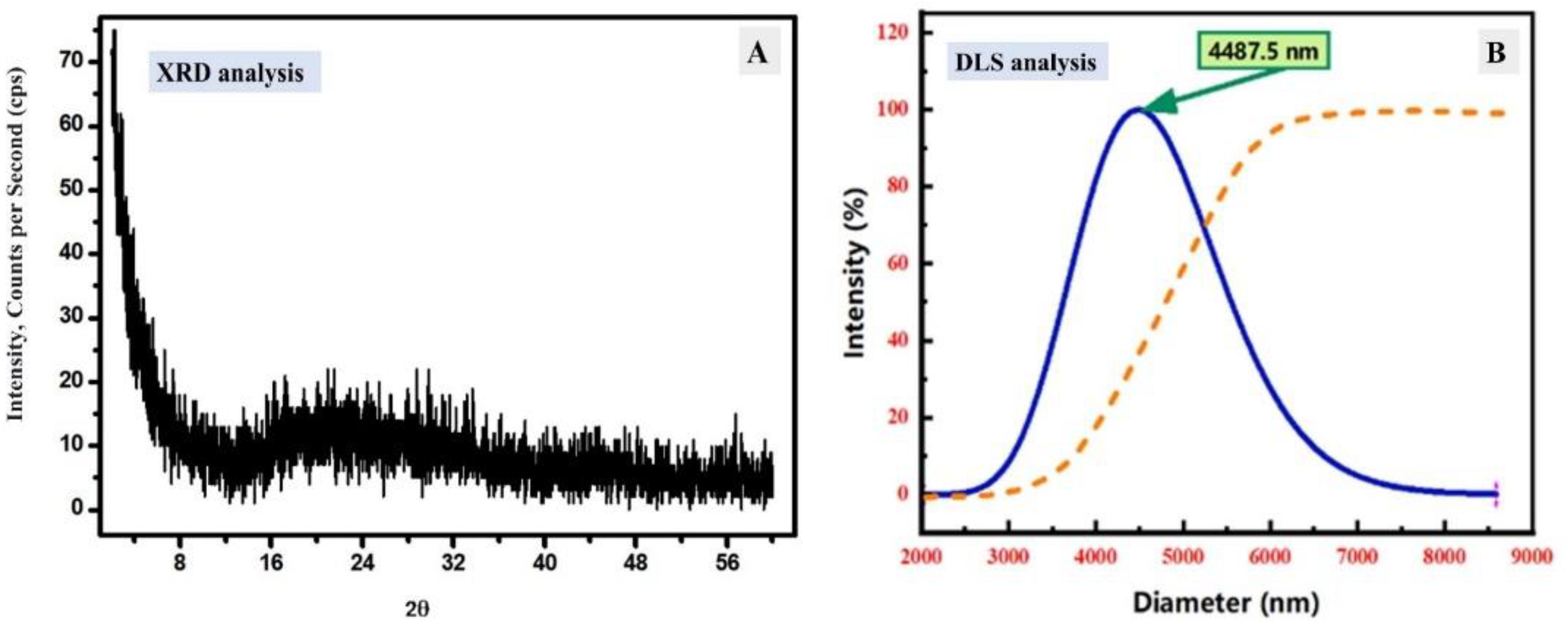
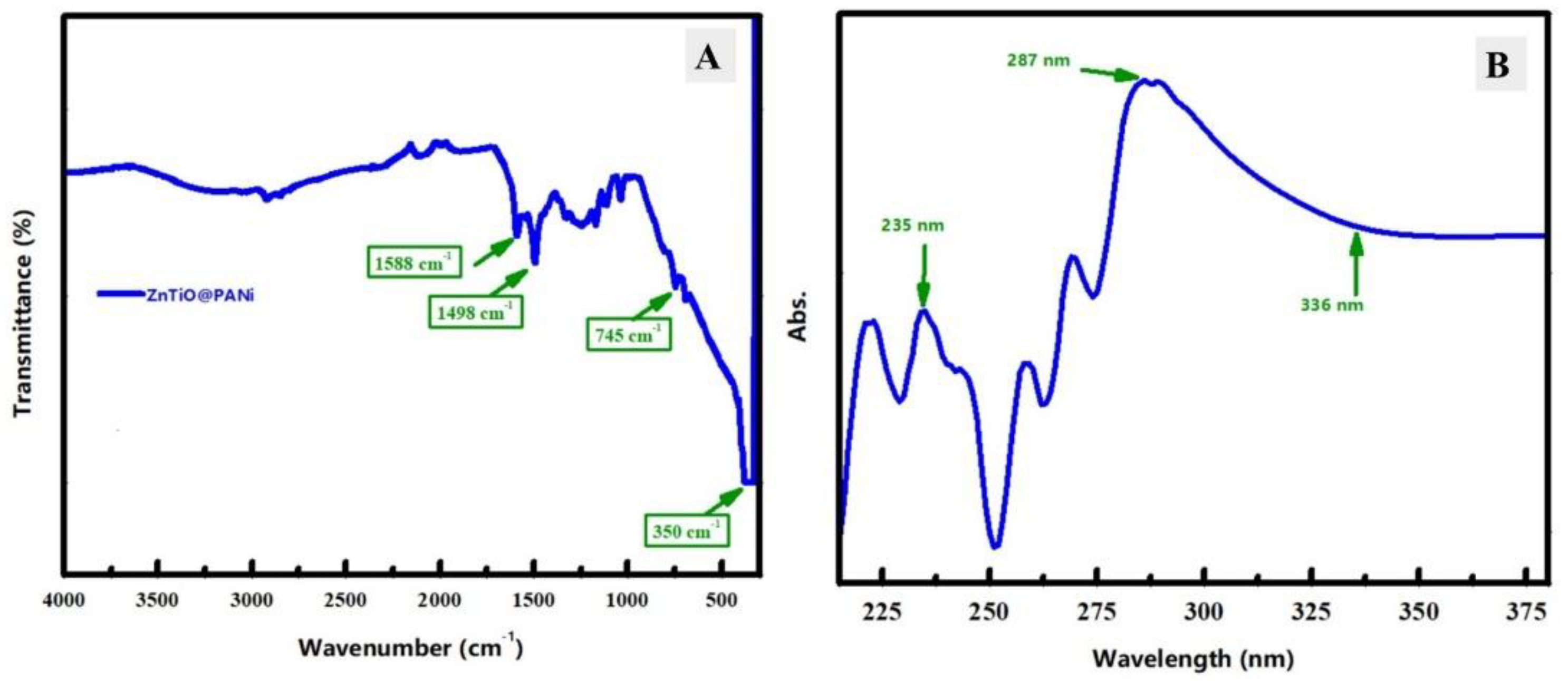
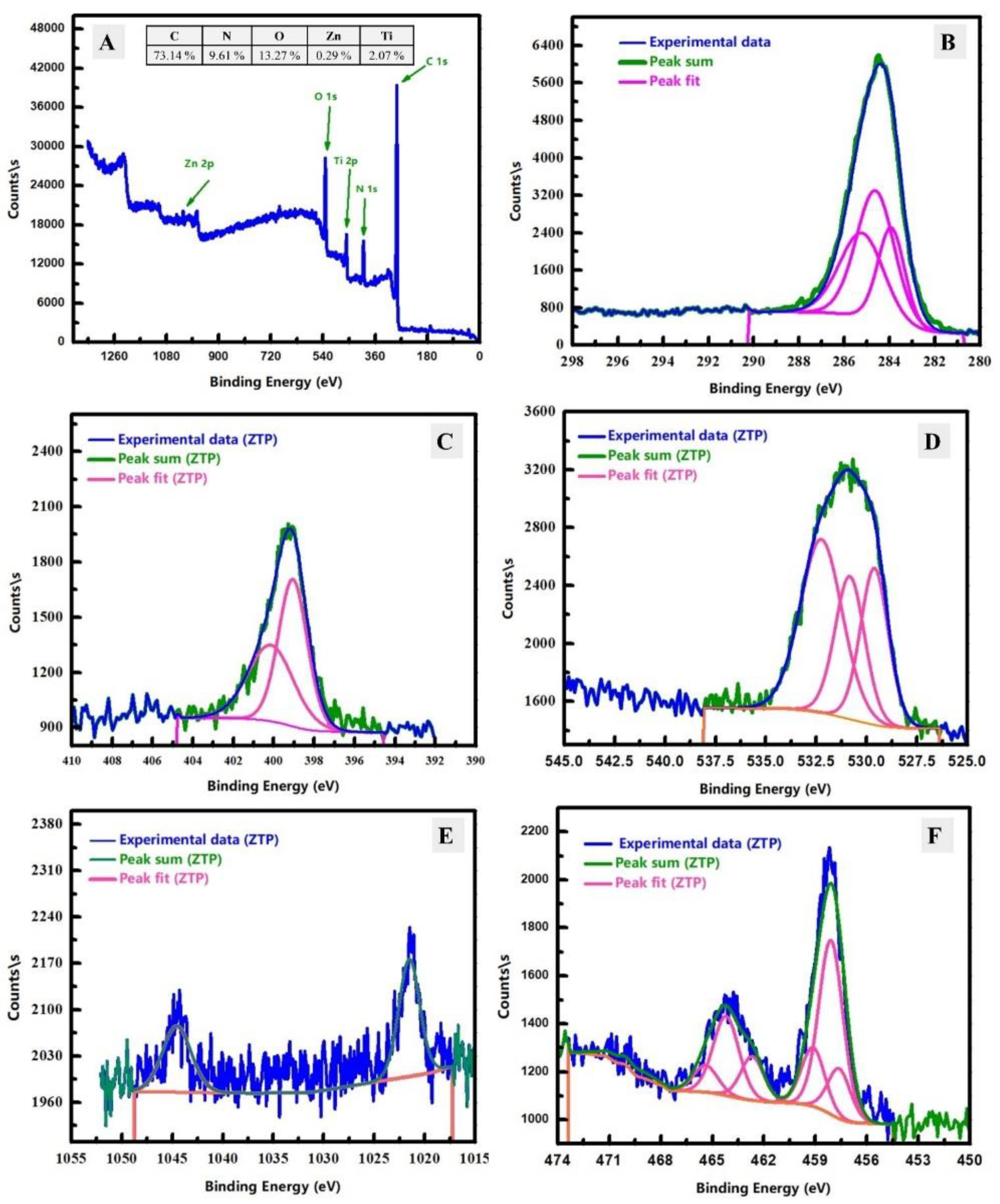

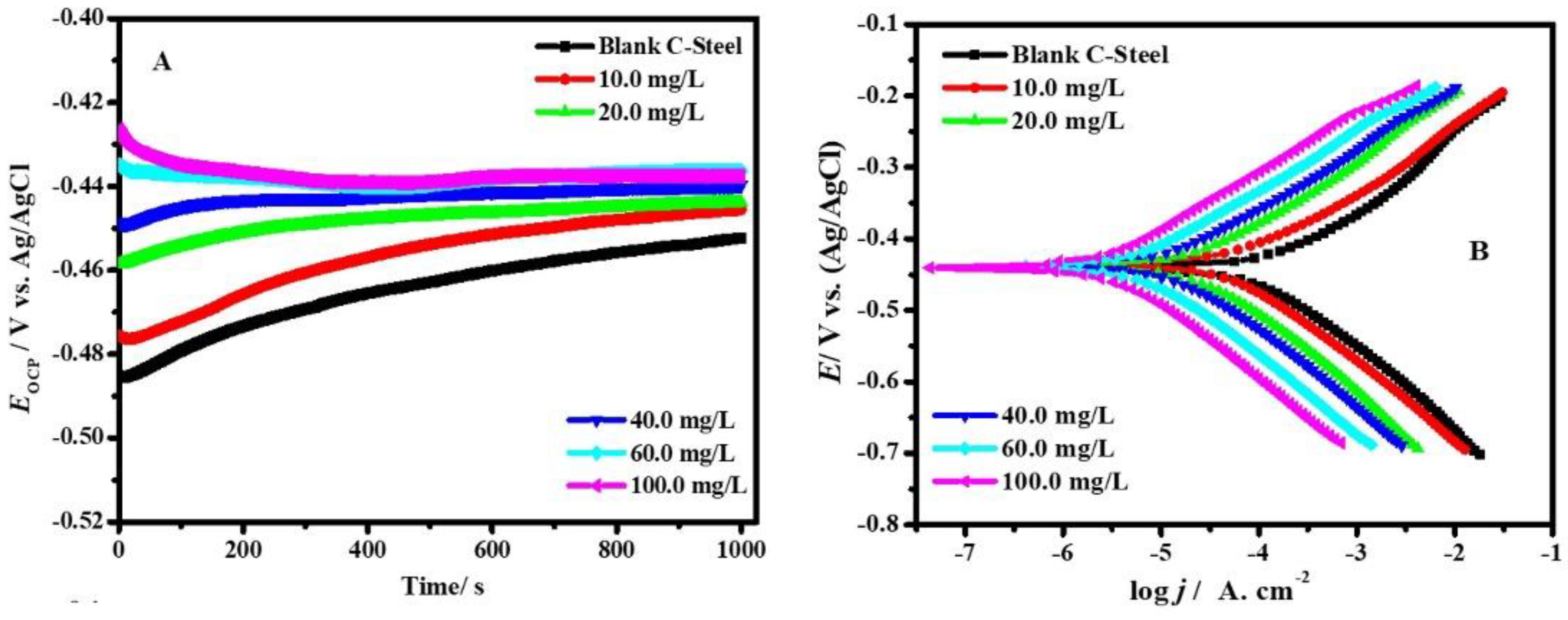
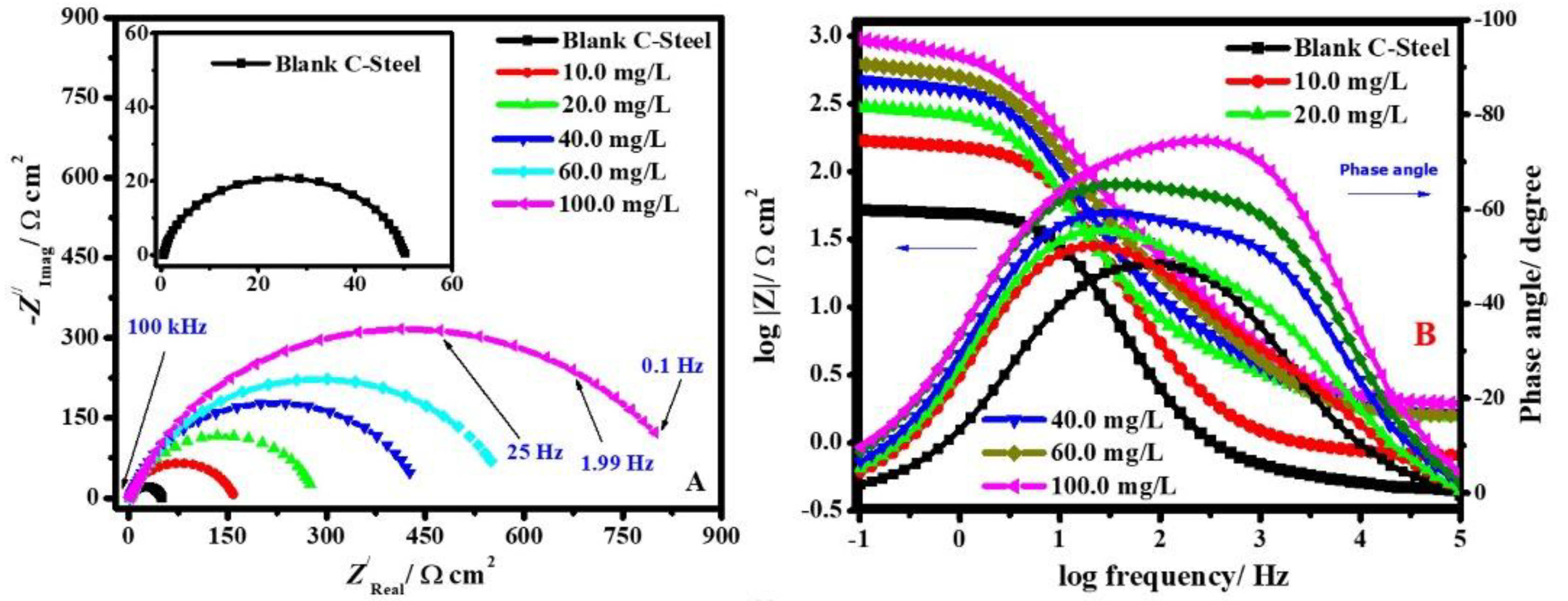
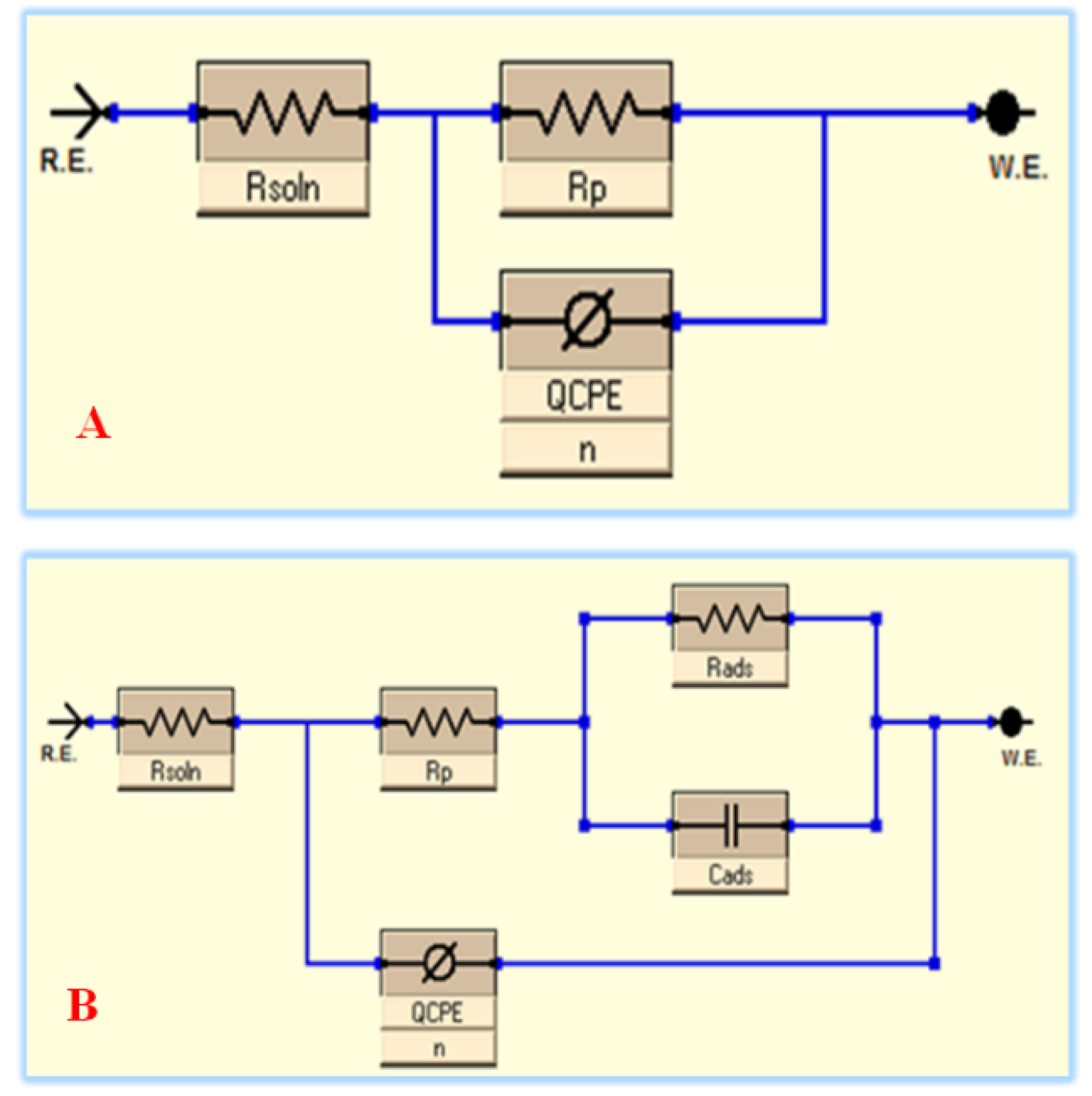


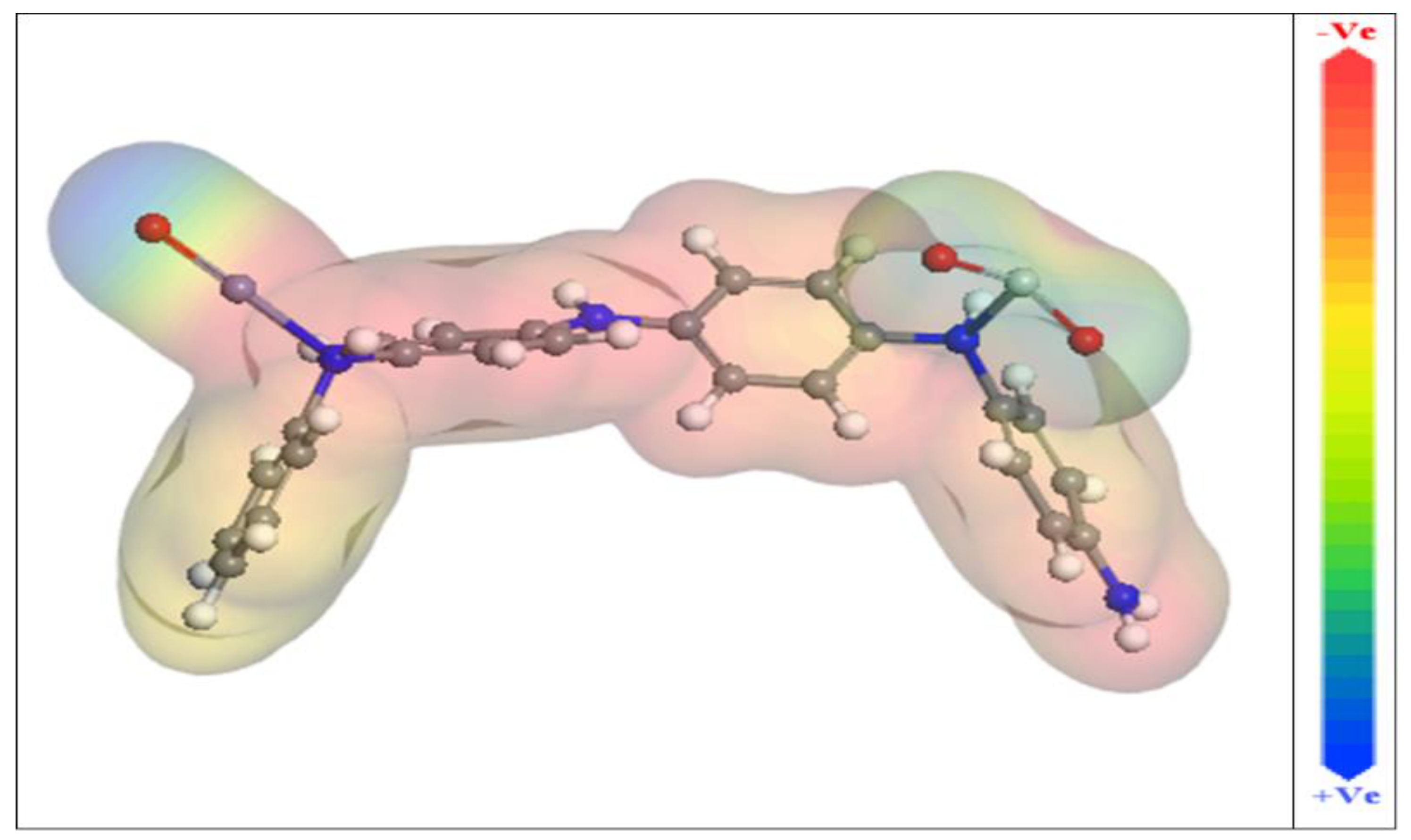
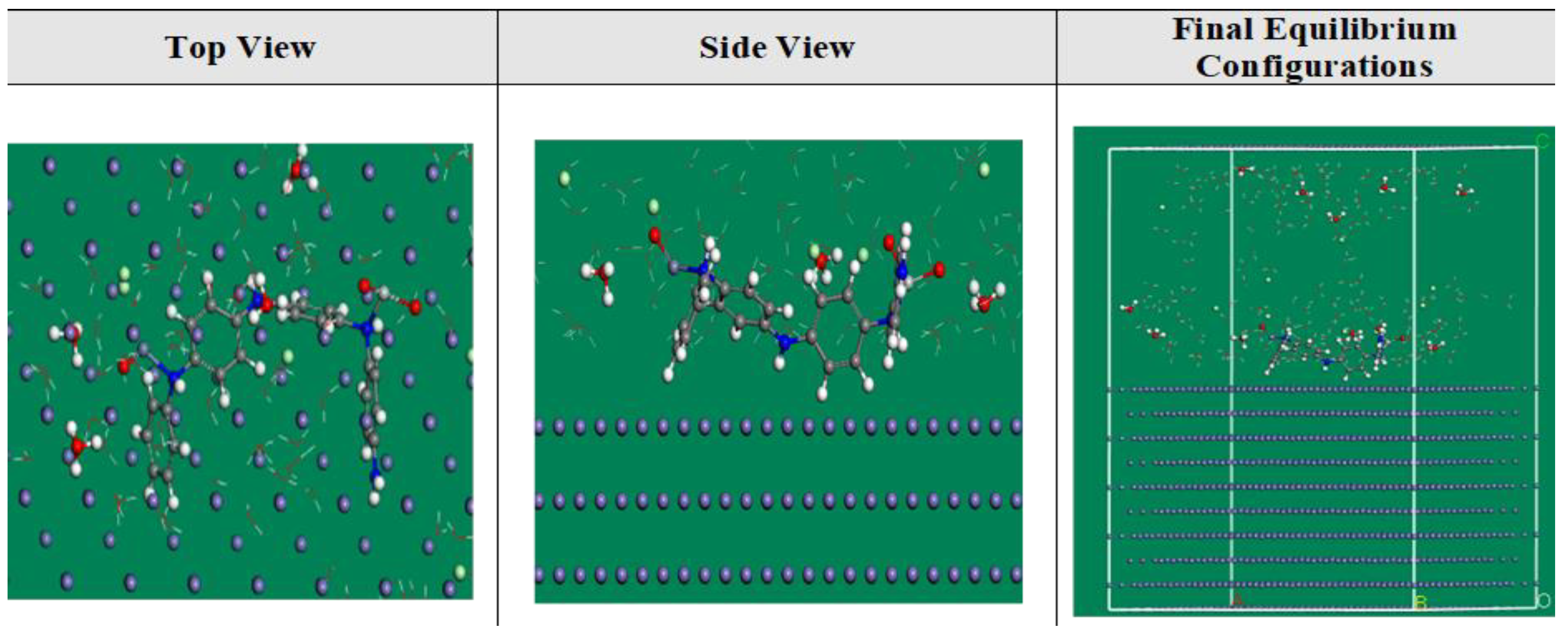
| Element | C | Cr | Mn | P | S | Si | Fe |
|---|---|---|---|---|---|---|---|
| Percentage/% | 0.29 | 0.15 | 0.88 | 0.034 | 0.039 | 0.18 | 98.607 |
| Systems | Cinh./ mg/L | Jcor/ µA cm−2 | CR/mmp ±SD | −Ecor/ mV (Ag/AgCl) | βa/ mV dec −1 | −βc/ mV dec −1 | θ | ηt/% |
|---|---|---|---|---|---|---|---|---|
| Blank | 0.0 | 978.42 | 77.34 ± 5.3 | 444 ± 25 | 72.83 | 167.38 | - | - |
| PANi | 100 | 175.03 | 13.84 ± 1.1 | 456 ± 29 | 78.39 | 170.65 | 0.821 | 82.11 |
| ZnTiO@PANi | 10 | 568.35 | 44.93 ± 3.7 | 436 ± 21 | 71.32 | 170.93 | 0.419 | 41.91 |
| 20 | 356.52 | 28.23 ± 2.4 | 439 ± 15 | 75.66 | 166.44 | 0.635 | 63.56 | |
| 40 | 183.37 | 14.54 ± 1.5 | 438 ± 12 | 79.52 | 168.04 | 0.812 | 81.26 | |
| 60 | 58.50 | 4.64 ± 0.5 | 440 ± 19 | 77.54 | 167.18 | 0.940 | 94.02 | |
| 100 | 11.15 | 0.93 ± 0.06 | 438 ± 20 | 78.77 | 171.24 | 0.988 | 98.86 |
| Additive Codes | Cinh./ mol/L | Rs/ Ωcm2 | RP/ Ωcm2 ±SD | Cdl/ Fcm−2 × 10−6 | QCPE | χ2 × 10−4 | θ | ηE/% | |
|---|---|---|---|---|---|---|---|---|---|
| Y0/ μΩ−1 sn cm−2 | n | ||||||||
| Uninhibited | 0.0 | 0.54 | 51.8 ± 3.6 | 460.81 | 58.58 | 0.743 | 5.41 | -- | -- |
| PANi | 100 | 1.2 | 432.7 ± 34.1 | 82.43 | 9.01 | 0.837 | 4.54 | 0.880 | 88.0 |
| ZnTiO@PANi | 10 | 1.15 | 166.1 ± 14.1 | 147.07 | 28.11 | 0.838 | 5.32 | 0.688 | 68.8 |
| 20 | 2.71 | 293.3 ± 21.6 | 121.46 | 20.17 | 0.848 | 4.93 | 0.823 | 82.3 | |
| 40 | 3.23 | 463.4 ± 35.8 | 76.09 | 14.82 | 0.874 | 5.82 | 0.888 | 88.8 | |
| 60 | 3.79 | 615.6 ± 42.4 | 40.97 | 10.83 | 0.868 | 5.45 | 0.915 | 91.5 | |
| 100 | 4.07 | 963.7 ± 39.7 | 24.22 | 8.73 | 0.865 | 4.53 | 0.946 | 94.6 | |
| Parameters | PANi | ZO@PANi | ZnTiO@PANi |
|---|---|---|---|
| EHOMO/eV | −4.93 | −4.51 | −4.15 |
| ELUMO/eV | −1.87 | −2.03 | −3.00 |
| ΔE= ELUMO − EHOMO/eV | 3.06 | 2.46 | 1.16 |
| µ/Debye | 7.06 | 12.72 | 23.71 |
| η | 1.53 | 1.25 | 0.58 |
| ∆Eback-donation | −0.38 | −0.31 | −0.14 |
| ω | 3.76 | 4.28 | 11.06 |
| ΔN | 1.19 | 1.51 | 2.96 |
| χ | 3.41 | 3.28 | 3.57 |
| σ | 0.66 | 0.81 | 1.73 |
| Corrosion Systems | Adsorption Energy/ kcal mol−1 | Rigid Adsorption Energy/ kcal mol−1 | Deformation Energy/ kcal mol−1 | dEads/dNi: Inhibitor kcal mol−1 | dEads/dNi: Cl− Ions kcal mol−1 | dEads/dNi: HYDRONIUM kcal mol−1 | dEads/dNi: Water kcal mol−1 |
|---|---|---|---|---|---|---|---|
| Fe (110) | −1831.61 | −1533.32 | −298.41 | −219.81 | −95.62 | −54.05 | −17.26 |
| PANi | |||||||
| Water | |||||||
| Hydronium | |||||||
| Cl- ions | |||||||
| Fe (110) | −1938.63 | −1589.97 | −348.63 | −273.21 | −96.12 | −54.90 | −17.76 |
| ZO@PANi | |||||||
| Water | |||||||
| Hydronium | |||||||
| Cl- ions | |||||||
| Fe (110) | −2113.72 | −1712.61 | −401.33 | −321.06 | −95.76 | −54.65 | −17.29 |
| ZnTiO@PANi | |||||||
| Water | |||||||
| Hydronium | |||||||
| Cl- ions |
| Compound | Alloys\Metal | Inhibitor Concentration | Methods Used | Protection Capacity/% | References |
|---|---|---|---|---|---|
| ZnTiO@PANi | CS-alloy | 100 mg/L−1 | Eocp, EIS, and PDP | 98.8 | Present work |
| Tl2O3-SiO2/PANI | C-steel | 10-150 mg/L−1 | EIS, PDP, EOCP, HRTEM, and SEM | 52.4–93.8 | [4] |
| polyaniline–nano-TiO2 composites | steel | 13–41.8% of TiO2 in product | EOCP, SEM, TEM | 92.1 | [59] |
| Epoxy/polyaniline–ZnO nanorods | steel | 1.3–4.9% of ZnO in product | EOCP, SEM, and EIS | 94.3 | [60] |
| PANI/Ag | Al1050 alloy | Coated film | CV, SEM, and EIS | 97.5 | [61] |
| PANI/Zn | Al1050 alloy | Coated film | CV, SEM, and EIS | 92.5 | [61] |
| Fe2O3/PPy | Mild steel | Coated film | EIS and EOCP | 91.6 | [62] |
| Epoxy/MgO NPs coatings | Mild steel | Coated film | SEM | 93.7 | [63] |
| polyaniline functionalized ZnO-SiO2 nanoparticles | CS-alloy | 150 ppm | EIS and PDP | 98.6 | [22] |
Publisher’s Note: MDPI stays neutral with regard to jurisdictional claims in published maps and institutional affiliations. |
© 2022 by the authors. Licensee MDPI, Basel, Switzerland. This article is an open access article distributed under the terms and conditions of the Creative Commons Attribution (CC BY) license (https://creativecommons.org/licenses/by/4.0/).
Share and Cite
Al-Masoud, M.A.; Khalaf, M.M.; Gouda, M.; Dao, V.-D.; Mohamed, I.M.A.; Shalabi, K.; Abd El-Lateef, H.M. Synthesis and Characterization of the Mixed Metal Oxide of ZnO-TiO2 Decorated by Polyaniline as a Protective Film for Acidic Steel Corrosion: Experimental, and Computational Inspections. Materials 2022, 15, 7589. https://doi.org/10.3390/ma15217589
Al-Masoud MA, Khalaf MM, Gouda M, Dao V-D, Mohamed IMA, Shalabi K, Abd El-Lateef HM. Synthesis and Characterization of the Mixed Metal Oxide of ZnO-TiO2 Decorated by Polyaniline as a Protective Film for Acidic Steel Corrosion: Experimental, and Computational Inspections. Materials. 2022; 15(21):7589. https://doi.org/10.3390/ma15217589
Chicago/Turabian StyleAl-Masoud, May Ahmed, Mai M. Khalaf, Mohamed Gouda, Van-Duong Dao, Ibrahim M. A. Mohamed, Kamal Shalabi, and Hany M. Abd El-Lateef. 2022. "Synthesis and Characterization of the Mixed Metal Oxide of ZnO-TiO2 Decorated by Polyaniline as a Protective Film for Acidic Steel Corrosion: Experimental, and Computational Inspections" Materials 15, no. 21: 7589. https://doi.org/10.3390/ma15217589
APA StyleAl-Masoud, M. A., Khalaf, M. M., Gouda, M., Dao, V.-D., Mohamed, I. M. A., Shalabi, K., & Abd El-Lateef, H. M. (2022). Synthesis and Characterization of the Mixed Metal Oxide of ZnO-TiO2 Decorated by Polyaniline as a Protective Film for Acidic Steel Corrosion: Experimental, and Computational Inspections. Materials, 15(21), 7589. https://doi.org/10.3390/ma15217589










